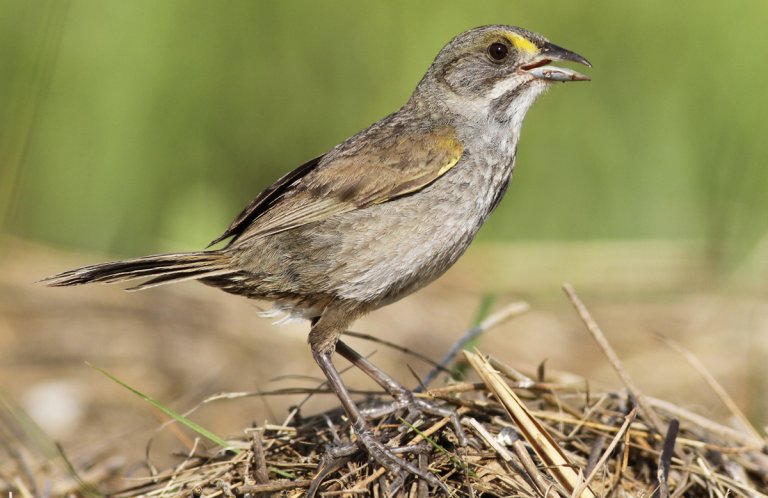 Like the ‘Io (Hawaiian Hawk) and ‘Ua‘u (Hawaiian Petrel), the ‘Alae ‘Ula, or Hawaiian Common Gallinule, is revered in folklore. According to legend, this bird brought fire from the gods to the people, burning its white forehead red in the process. In fact, its Hawaiian name, ‘Alae ‘Ula, means “burnt forehead!”
Like the ‘Io (Hawaiian Hawk) and ‘Ua‘u (Hawaiian Petrel), the ‘Alae ‘Ula, or Hawaiian Common Gallinule, is revered in folklore. According to legend, this bird brought fire from the gods to the people, burning its white forehead red in the process. In fact, its Hawaiian name, ‘Alae ‘Ula, means “burnt forehead!”
The ‘Alae ‘Ula is one of 12 subspecies of Common Gallinule, which is found worldwide. (It differs slightly from the more familiar Common Gallinule in having a reddish blush on the front of its legs and a more extensive facial shield.)
The Hawaiian Common Gallinule was once found throughout the Hawaiian archipelago, but now occurs only on the islands of Kaua‘i and O‘ahu—mainly due to loss of habitat and invasive species such as domestic cats.
Surveying a Subspecies
‘Alae ‘Ula are territorial and defend an area of wetland ranging from a quarter-acre to a half-acre. Although not as secretive as other members of the rail family, such as the elusive Black Rail, this gallinule's preferred habitat—dense aquatic vegetation—can complicate efforts to accurately estimate its population size.
Both sexes appear similar, although males are larger, and both give voice to chicken-like cackles and croaks. The birds cannot fly for about 25 days each year during their molting period, usually from June-September, which increases their vulnerability to predation.
Feeding Behind a Shield
The ‘Alae ‘Ula's striking red frontal shield is thought to protect its face as the bird forages through dense vegetation for grasses, seeds, mollusks, and aquatic insects and their larvae. The shield may also be used in courtship display and territorial defense.
‘Alae ‘Ula are opportunistic feeders. They may take food from the water's surface, dip or dive underwater, or turn over aquatic vegetation as they seek prey.
Platform Nesting
‘Alae ‘Ula can nest year-round, but the majority of nesting occurs from March to August and may depend on suitable water levels. This bird's platform-style nest is built from twigs, stems, and leaves, with the male collecting materials and the female arranging them at the nest site. The parents frequently incorporate a ramp on one side to allow chicks to easily clamber in and out.

Hawaiian Common Gallinule by Michael Walther
Female gallinules lay a clutch of around five eggs, which hatch after two to three weeks of incubation by both sexes. Like Wilson's Plover and Piping Plover chicks, ‘Alae ‘Ula hatchlings are precocial: They can walk and swim within a few hours of hatching. However, they depend on their parents for protection and food for several more weeks.
Rekindling the Fire-bringer
The Hawaiian Common Gallinule was listed as Endangered under the U.S. Endangered Species Act (ESA) in 1967; it's also listed as endangered at the state level. The filling, dredging, and draining of wetlands in Hawai'i has greatly reduced the amount of habitat available for the gallinule, limiting their distribution and abundance.
Introduced predators such as cats, mongooses, bullfrogs, and turtles are another problem for the ground-feeding birds. And climate change, particularly rising sea level, threatens the species' low-lying coastal habitat.
ABC recently joined with several partner groups to ask Congress to support a new conservation effort in Hawai‘i that would provide increased funding for endangered endemic birds. Together with our partners, we're undertaking many other conservation efforts to help prevent extinction of Hawaiian birds.
Donate to support ABC's conservation mission!



















































